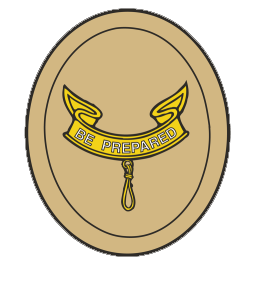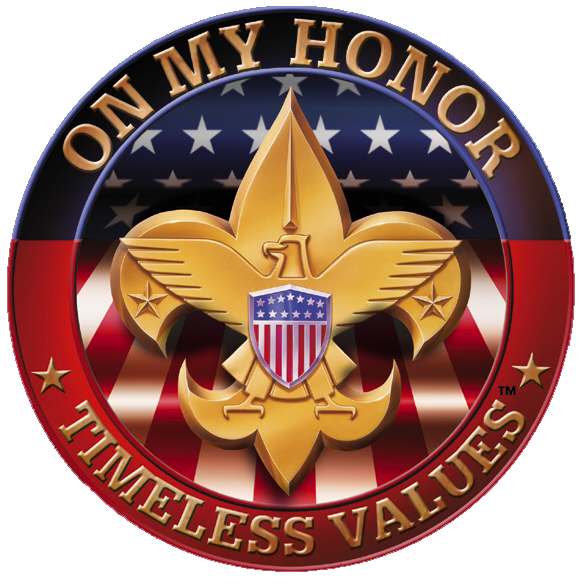




NOTE: These requirements are in effect beginning January 1, 2024. They may be worked on simultaneously with those for Scout, Tenderfoot and First Class; however these ranks must be earned in sequence. Click the following link to view video clips of the requirements for Second Class.
Camping and Outdoor Ethics
1a. Since joining Scouts BSA, participate in five separate troop/patrol activities, at least three of which must
be held outdoors. Of the outdoor activities, at least two must include overnight camping. These
activities do not include troop or patrol meetings. On campouts, spend the night in a tent that you pitch
or other structure that you help erect, such as a lean-to, snow cave, or tepee.
1b. Recite the Leave No Trace Seven Principles from memory. Explain how you follow them on all outings.
1c. On one of these campouts, select a location for your patrol site and recommend it to your patrol
leader, senior patrol leader, or troop guide. Explain what factors you should consider when choosing a
patrol site and where to pitch a tent.
Cooking and Tools
The meals prepared for Second Class rank requirement 2e may not count toward Cooking merit badge,
requirements 4, 5, or 6. Meals prepared for Cooking merit badge requirements 4, 5, and 6 may not count
toward Second Class rank requirement 2e.
2a. Explain when it is appropriate to use a fire for cooking or other purposes and when it would not be
appropriate to do so.
2b. Use a pocketknife, and a saw or axe if needed, to prepare tinder, kindling, and fuel wood for a cooking
fire.
2c. Using a minimum-impact method, and at an approved outdoor location and time, use the tinder,
kindling, and fuel wood from Second Class requirement 2b to demonstrate how to build a fire. Unless
prohibited by local fire restrictions, light the fire. After allowing the flames to burn safely for at least two
minutes, safely extinguish the flames with minimal impact to the fire site. Properly dispose of the ashes
and any charred remains.
2d. Explain when it is appropriate to use a lightweight stove and when it is appropriate to use a propane
stove. Set up a lightweight stove or propane stove. Unless prohibited by local fire restrictions, light the
stove. Describe the safety procedures for using these types of stoves.
2e. On one campout, plan and cook one hot breakfast or lunch, selecting foods from MyPlate or the
current USDA nutritional model. Explain the importance of good nutrition. Demonstrate how to
transport, store, and prepare the foods you selected.
2f. Demonstrate tying the sheet bend knot. Describe a situation in which you would use this knot.
2g. Demonstrate tying the bowline knot. Describe a situation in which you would use this knot.
Navigation
3a. Demonstrate how a compass works and how to orient a map. Use a map to point out and tell the
meaning of five map symbols.
3b. Using a compass and map together, take a 5-mile hike (or 10 miles by bike) approved by your adult
leader and your parent or guardian.*
3c. Describe some hazards or injuries that you might encounter on your hike and what you can do to help
prevent them.
3d. Demonstrate how to find directions during the day and at night without using a compass or an
electronic device.
Nature
4. Identify or show evidence of at least 10 kinds of wild animals (such as birds, mammals, reptiles, fish,
or mollusks) found in your local area or camping location. You may show evidence by tracks, signs, or
photographs you have taken.
Aquatics
5a. Tell what precautions must be taken for a safe swim.
5b. Demonstrate your ability to pass the BSA beginner test: Jump feet first into water over your head in
depth, level off and swim 25 feet on the surface, stop, turn sharply, resume swimming, then return to
your starting place.
5c. Demonstrate water rescue methods by reaching with your arm or leg, by reaching with a suitable
object, and by throwing lines and objects.
5d. Explain why swimming rescues should not be attempted when a reaching or throwing rescue is
possible. Explain why and how a rescue swimmer should avoid contact with the victim.
First Aid and Emergency Preparedness
6a. Demonstrate first aid for the following:
- Object in the eye
- Bite of a warm-blooded animal
- Puncture wounds from a splinter, nail, and fishhook
- Serious burns (partial thickness, or second-degree)
- Heat exhaustion
- Shock
- Heatstroke, dehydration, hypothermia, and hyperventilation
6b. Show what to do for “hurry” cases of stopped breathing, stroke, severe bleeding, and ingested
poisoning.
6c. Tell what you can do while on a campout or hike to prevent or reduce the occurrence of the injuries
listed in Second Class requirements 6a and 6b.
6d. Explain what to do in case of accidents that require emergency response in the home and
backcountry. Explain what constitutes an emergency and what information you will need to provide to
a responder.
6e. Tell how you should respond if you come upon the scene of a vehicular accident.
Fitness
7a. After completing Tenderfoot requirement 6c, be physically active at least 30 minutes each day for five
days a week for four weeks. Keep track of your activities.
7b. Share your challenges and successes in completing Second Class requirement 7a. Set a goal for
continuing to include physical activity as part of your daily life and develop a plan for doing so.
7c. Participate in a school, community, or troop program on the dangers of using drugs, alcohol, and
tobacco and other practices that could be harmful to your health. Discuss your participation in the
program with your family, and explain the dangers of substance addictions. Report to your
Scoutmaster or other adult leader in your troop about which parts of the Scout Oath and Scout Law
relate to what you learned.
Citizenship
8a. Participate in a flag ceremony for your school, religious institution, chartered organization, community,
or Scouting activity.
8b. Explain what respect is due the flag of the United States.
8c. With your parents or guardian, decide on an amount of money that you would like to earn, based on
the cost of a specific item you would like to purchase. Develop a written plan to earn the amount
agreed upon and follow that plan; it is acceptable to make changes to your plan along the way.
Discuss any changes made to your original plan and whether you met your goal.
8d. At a minimum of three locations, compare the cost of the item for which you are saving to determine
the best place to purchase it. After completing Second Class requirement 8c, decide if you will use
the amount that you earned as originally intended, save all or part of it, or use it for another purpose.
8e. Participate in two hours of service through one or more service projects approved by your Scoutmaster.
Tell how your service to others relates to the Scout Oath.
Personal Safety Awareness
9a. Explain the three R’s of personal safety and protection.
9b. Describe bullying; tell what the appropriate response is to someone who is bullying you or another
person.
Scout Spirit
10. Demonstrate Scout spirit by living the Scout Oath and Scout Law. Tell how you have done your duty to
God and how you have lived four different points of the Scout Law (not to include those used for
Tenderfoot requirement 9) in your everyday life.
11. While working toward the Second Class rank, and after completing Tenderfoot requirement 10,
participate in a Scoutmaster conference.
12. Successfully complete your board of review for the Second Class rank.
* If you use a wheelchair or crutches, or if it is difficult for you to get around, you may substitute "trip" for "hike" in requirement 1b.
NOTE: Alternate Requirements for the Second Class rank are available for Scouts with physical or mental disabilities if they meet the criteria listed in the Boy Scout Requirements book. (The substitution mentioned in the footnote to item 1b does NOT require the actions listed under that topic.)
Camping and Outdoor Ethics
1a. Since joining Scouts BSA, participate in five separate troop/patrol activities, at least three of which must
be held outdoors. Of the outdoor activities, at least two must include overnight camping. These
activities do not include troop or patrol meetings. On campouts, spend the night in a tent that you pitch
or other structure that you help erect, such as a lean-to, snow cave, or tepee.
1b. Recite the Leave No Trace Seven Principles from memory. Explain how you follow them on all outings.
1c. On one of these campouts, select a location for your patrol site and recommend it to your patrol
leader, senior patrol leader, or troop guide. Explain what factors you should consider when choosing a
patrol site and where to pitch a tent.
Cooking and Tools
The meals prepared for Second Class rank requirement 2e may not count toward Cooking merit badge,
requirements 4, 5, or 6. Meals prepared for Cooking merit badge requirements 4, 5, and 6 may not count
toward Second Class rank requirement 2e.
2a. Explain when it is appropriate to use a fire for cooking or other purposes and when it would not be
appropriate to do so.
2b. Use a pocketknife, and a saw or axe if needed, to prepare tinder, kindling, and fuel wood for a cooking
fire.
2c. Using a minimum-impact method, and at an approved outdoor location and time, use the tinder,
kindling, and fuel wood from Second Class requirement 2b to demonstrate how to build a fire. Unless
prohibited by local fire restrictions, light the fire. After allowing the flames to burn safely for at least two
minutes, safely extinguish the flames with minimal impact to the fire site. Properly dispose of the ashes
and any charred remains.
2d. Explain when it is appropriate to use a lightweight stove and when it is appropriate to use a propane
stove. Set up a lightweight stove or propane stove. Unless prohibited by local fire restrictions, light the
stove. Describe the safety procedures for using these types of stoves.
2e. On one campout, plan and cook one hot breakfast or lunch, selecting foods from MyPlate or the
current USDA nutritional model. Explain the importance of good nutrition. Demonstrate how to
transport, store, and prepare the foods you selected.
2f. Demonstrate tying the sheet bend knot. Describe a situation in which you would use this knot.
2g. Demonstrate tying the bowline knot. Describe a situation in which you would use this knot.
Navigation
3a. Demonstrate how a compass works and how to orient a map. Use a map to point out and tell the
meaning of five map symbols.
3b. Using a compass and map together, take a 5-mile hike (or 10 miles by bike) approved by your adult
leader and your parent or guardian.*
3c. Describe some hazards or injuries that you might encounter on your hike and what you can do to help
prevent them.
3d. Demonstrate how to find directions during the day and at night without using a compass or an
electronic device.
Nature
4. Identify or show evidence of at least 10 kinds of wild animals (such as birds, mammals, reptiles, fish,
or mollusks) found in your local area or camping location. You may show evidence by tracks, signs, or
photographs you have taken.
Aquatics
5a. Tell what precautions must be taken for a safe swim.
5b. Demonstrate your ability to pass the BSA beginner test: Jump feet first into water over your head in
depth, level off and swim 25 feet on the surface, stop, turn sharply, resume swimming, then return to
your starting place.
5c. Demonstrate water rescue methods by reaching with your arm or leg, by reaching with a suitable
object, and by throwing lines and objects.
5d. Explain why swimming rescues should not be attempted when a reaching or throwing rescue is
possible. Explain why and how a rescue swimmer should avoid contact with the victim.
First Aid and Emergency Preparedness
6a. Demonstrate first aid for the following:
- Object in the eye
- Bite of a warm-blooded animal
- Puncture wounds from a splinter, nail, and fishhook
- Serious burns (partial thickness, or second-degree)
- Heat exhaustion
- Shock
- Heatstroke, dehydration, hypothermia, and hyperventilation
6b. Show what to do for “hurry” cases of stopped breathing, stroke, severe bleeding, and ingested
poisoning.
6c. Tell what you can do while on a campout or hike to prevent or reduce the occurrence of the injuries
listed in Second Class requirements 6a and 6b.
6d. Explain what to do in case of accidents that require emergency response in the home and
backcountry. Explain what constitutes an emergency and what information you will need to provide to
a responder.
6e. Tell how you should respond if you come upon the scene of a vehicular accident.
Fitness
7a. After completing Tenderfoot requirement 6c, be physically active at least 30 minutes each day for five
days a week for four weeks. Keep track of your activities.
7b. Share your challenges and successes in completing Second Class requirement 7a. Set a goal for
continuing to include physical activity as part of your daily life and develop a plan for doing so.
7c. Participate in a school, community, or troop program on the dangers of using drugs, alcohol, and
tobacco and other practices that could be harmful to your health. Discuss your participation in the
program with your family, and explain the dangers of substance addictions. Report to your
Scoutmaster or other adult leader in your troop about which parts of the Scout Oath and Scout Law
relate to what you learned.
Citizenship
8a. Participate in a flag ceremony for your school, religious institution, chartered organization, community,
or Scouting activity.
8b. Explain what respect is due the flag of the United States.
8c. With your parents or guardian, decide on an amount of money that you would like to earn, based on
the cost of a specific item you would like to purchase. Develop a written plan to earn the amount
agreed upon and follow that plan; it is acceptable to make changes to your plan along the way.
Discuss any changes made to your original plan and whether you met your goal.
8d. At a minimum of three locations, compare the cost of the item for which you are saving to determine
the best place to purchase it. After completing Second Class requirement 8c, decide if you will use
the amount that you earned as originally intended, save all or part of it, or use it for another purpose.
8e. Participate in two hours of service through one or more service projects approved by your Scoutmaster.
Tell how your service to others relates to the Scout Oath.
Personal Safety Awareness
9a. Explain the three R’s of personal safety and protection.
9b. Describe bullying; tell what the appropriate response is to someone who is bullying you or another
person.
Scout Spirit
10. Demonstrate Scout spirit by living the Scout Oath and Scout Law. Tell how you have done your duty to
God and how you have lived four different points of the Scout Law (not to include those used for
Tenderfoot requirement 9) in your everyday life.
11. While working toward the Second Class rank, and after completing Tenderfoot requirement 10,
participate in a Scoutmaster conference.
12. Successfully complete your board of review for the Second Class rank.
* If you use a wheelchair or crutches, or if it is difficult for you to get around, you may substitute "trip" for "hike" in requirement 1b.
NOTE: Alternate Requirements for the Second Class rank are available for Scouts with physical or mental disabilities if they meet the criteria listed in the Boy Scout Requirements book. (The substitution mentioned in the footnote to item 1b does NOT require the actions listed under that topic.)



You are visitor number
Since March 17, 2013





















